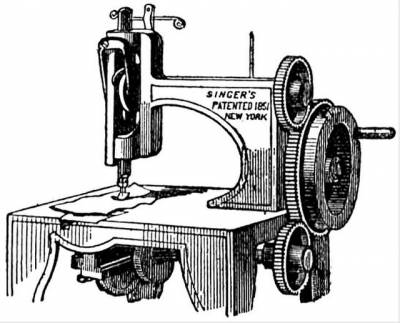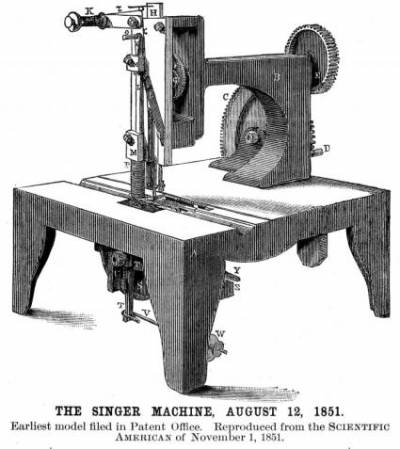The Inventor of the Sewing Machine Issac Singer
Tips and tricks.
The Inventor of the Sewing Machine Issac Singer
In the annals of history, there are few stories that capture the essence of innovation, determination, and the power to transform industries quite like the journey of Isaac Singer. Born into humble beginnings, Singer defied all odds to become a household name and a pioneer in the world of sewing machines. Through his unwavering dedication and relentless pursuit of excellence, Singer revolutionized the way clothes were made and forever changed the landscape of the fashion industry.

Issac Singer
Early life and background of Isaac Singer
Isaac Merritt Singer was born on October the 27th, 1811, in Pittstown, New York. The son of German immigrants, Singer grew up in a large poor family. From a very young age, he displayed extraordinary mechanical aptitude, often tinkering with household items and inventing things to make his family's life easier. However, his talents were not recognized until much later durnig his life.
In his youth, he pursued a career in acting, which took him on various theatrical tours across the United States. While his acting career saw moderate success, it was during this time that Singer encountered a problem that would change the trajectory of his life. He noticed the inefficiency and labor-intensive nature of hand-sewing, which sparked his interest in coming up with a solution to streamline the process.
The invention of the sewing machine and its impact on society

Driven by his desire to improve the existing methods of sewing, he began experimenting with different designs and mechanisms. In 1851, he patented his first sewing machine, which incorporated several innovative features that set it apart from previous inventions. The machine utilized a vertical needle motion, a presser foot, and a tension system that ensured even stitching. This breakthrough in sewing technology marked the beginning of a revolution in the textile industry.
The impact of Singer's invention was profound. Before the invention, the production of clothing was a laborious time-consuming task. Sewing by hand was slow, prone to errors, and required highly skilled labor. With the introduction of Singer's sewing machine, the process became faster, more efficient, and accessible to a wider population. It not only transformed the way clothes were made but also had far-reaching social and economic implications.
Isaac Singer's contribution to sewing machine innovation
While Singer's initial design was revolutionary, he didn't stop there. Throughout his career, Singer continued to innovate and improve upon his invention. He introduced features such as automatic thread tension, adjustable stitch length, and the ability to sew in reverse. These advancements made sewing even more convenient and user-friendly, further solidifying Singer's reputation as a leading figure in sewing machine innovation.
His commitment to innovation extended beyond the sewing machine itself. He also developed a system of interchangeable parts, which enabled easy repairs and maintenance of his machines. This not only reduced downtime for users but also established a new standard in manufacturing. The concept of interchangeable parts that would later become a cornerstone of industrialization and mass production.
The rise of the Singer Sewing Machine Company

With the success of his sewing machine design and the increasing demand for his product, Singer went on to establish the Singer Manufacturing Company in 1851. The company quickly gained a reputation for producing high-quality sewing machines that were reliable and easy to use. Singer's marketing prowess and business acumen played a significant role in the company's success.
Singer employed various marketing and advertising strategies to promote his sewing machines. Singer also employed aggressive advertising campaigns, using newspaper advertisements, catalogs, and even traveling salesmen and even saleswoman, to showcase his machines. His efforts paid off, and by the late 19th century, Singer had become a household name synonymous with sewing machines. He also achieved great personal wealth and was one of the richest men in America
Isaac Singer's prowess extended beyond invention; he was a shrewd businessman. His approach to marketing and distribution played a crucial role in the success of his sewing machines. He introduced the installment payment plan, making the machines affordable to more people, which significantly boosted sales and popularity.
Challenges and controversies faced by Isaac Singer and his company
Despite his success, he faced numerous challenges and controversies throughout his career. One of the most notable controversies involved patent disputes with other inventors, most notably Elias Howe. Howe claimed that Singer had infringed his patent for the lockstitch sewing machine. The legal battle that ensued lasted for years and ultimately ended in a settlement in favor of Howe. However, Singer's reputation and market dominance remained largely unaffected.
Singer also faced criticism for his business practices, particularly his treatment of employees. The working conditions in Singer's factories were often harsh, and there were reports of long working hours and low wages. These controversies tarnished Singer's legacy to some extent and highlighted the ethical considerations that arose with the rise of industrialization.
Legacy and lasting impact of Isaac Singer and the Singer Sewing Machine Company
Despite the controversies surrounding him, there is no denying the lasting impact of Isaac Singer and his sewing machines. His inventions revolutionized the textile industry, transforming it from a labor-intensive craft to a mechanized process. The introduction of the sewing machine not only increased productivity but also opened up new opportunities for women in the workforce. Sewing machines became an essential tool in households and factories, paving the way for the mass production of clothing and the growth of the fashion industry.
The Singer Sewing Machine Company continued to thrive even after Singer's death in 1875. It expanded its operations globally and maintained its position as a leading manufacturer of sewing machines. The company diversified its product line, introducing new models and incorporating technological advancements. Today, the Singer brand is still recognized and respected, with its sewing machines continuing to be used by enthusiasts and professionals alike.
The evolution of the sewing machine industry after Isaac Singer
The legacy of Isaac Singer paved the way for further advancements in the sewing machine industry. His innovation and success inspired a new generation of inventors and entrepreneurs to push the boundaries of sewing technology. Over the years, sewing machines have evolved to incorporate computerized systems, embroidery capabilities, and advanced stitching techniques. These advancements have made sewing more accessible, precise, and efficient than ever before.
In addition to technological advancements, the sewing machine industry has also witnessed a shift in consumer preferences and trends. As fashion and design continue to evolve, sewing machines have adapted to meet the changing needs of users. Today, there are machines specifically designed for quilting, garment construction, and even specialized embroidery projects. The sewing machine industry remains vibrant and continues to innovate, building upon the foundation laid by Isaac Singer.
Isaac Singer's lasting legacy in the world of sewing machines
Isaac Singer's journey from humble beginnings to sewing machine success is a testament to the power of innovation, determination, and the ability to transform industries. Through his unwavering commitment to excellence and relentless pursuit of improvement, Singer revolutionized the way clothes were made and forever changed the landscape of the fashion industry.
Little-known facts about Issac Singer
Singer died in 1875 at the age of 64. He was a complex and contradictory figure. He was a brilliant inventor and businessman, but he was also a ruthless competitor and a womanizer. However, there is no doubt that he had a profound impact on the world. He made the sewing machine affordable and accessible to the masses, and he helped to revolutionize the way people dressed.
- Singer was a skilled actor, and he often used his acting skills to promote his sewing machines. He would put on demonstrations in department stores, and he would even dress up in costumes to entertain customers.
- He was a very wealthy man, but he was also a very generous philanthropist. He donated money to a number of charities, including hospitals, orphanages, and schools.
- He was a very eccentric man. He had a pet monkey named Jim, and he would often take Jim with him on business trips. He also had a collection of over 100 watches.
- was married four times, and he had 23 children. He was a very loving father, and he spent a lot of time with his children.
- He died in 1875 at the age of 64. He was buried in Mount Auburn Cemetery in Cambridge, Massachusetts.